Theodor Wieseler
 Vendor/Dealer
Vendor/Dealer
Süddeutsche Glasmanufaktur - Theodor Wieseler / Wieseler & Beeri / Wieseler & Mahler
Brunnengaße 22, Karolinenstraße 27, Kaiserstraße 4 & 18, König(s)straße 20, Nuremberg. Also Leipzigerstraße 64, Berlin & Erlangen, Bavaria.
Einrichtungs Magazin. / Department store
Königlich Bayerischer Hoflieferant. / Supplier to the Royal Bavarian Court
The entrance to the main shop has been at No. 27, Karolinenstraße since 1908, but before then, the entrance
was at what is now the rear of the shop, at No. 22 Brunnengaße, since those streets run parallel to each other.
Theodor Wieseler Snr. was born on 18th January 1859 in Langendorf, in the district of Bad Kissingen and died on 11th December 1924 in Nuremberg. Between 1880 and 1882 he was a representative for
F.W. Auerbach in Magdeburg. He joined the Bavarian army for one year, after which he became a representative, covering Bavaria, Baden & Württemberg for
C. W. Scheffler of Leipzig, a glass wholesaler. In 1885 he opened a new branch of C. W. Scheffler Niederlage, situated in Köhnstraße, Nuremberg. At the beginning of 1886 he purchased a property in Schoppershofstraße, moved the business and changed its name to Süddeutsche Glasmanufaktur - Theodor Wieseler.
In 1889/90, Julius Beeri became a partner for four or five years, with a new company Wieseler and Beeri. He was known to have signed a contract on behalf of Wieseler & Beeri - C.W. Scheffler in 1891. After 1894 he disappeared from the company records and by 1899 had disappeared from Nuremberg address books. In 1894, Kaiserstraße 18, was purchased as a glass decoration studio. Kaiserstraße 4, was used as a porcelain decoration studio.
In 1901, Ernst Mahler, the brother in law of Theodor Wieseler Snr. became both a partner in Süddeutsche Glasmanufaktur - Theodor Wieseler, together with a new company called Wieseler & Mahler. Meanwhile, in the same year, Theodor Snr. also co--founded and became a director of the "Nurnberger Bund" which is a purchasing and marketing co-operative, now based in Essen, North Rhine-Westphalia. Theodor Wieseler Jnr. joined the company in 1912, but was after a short while, required to do national service and again then conscripted into the army in 1914. Hans Kösters was brought in as general manager in 1915. Theodore Jnr. rejoined the company in 1919, and Hans Kösters was made a partner upon the death of Theodor Snr. Wieseler & Mahler also had a branch called "Der bunte Laden" at König(s)straße 20 from circa 1939. Also they opened a branch in Erlangen, post war which was open until the early 1990's. Since the 1st October 1998, the company has been owned by
W.M.F. Württembergische MetallwarenFabrik, and has been officially called W.M.F. Fachgeschäft Wieseler & Mahler A.G., but as of 2009 the shop still had the Wieseler & Mahler sign on the front of Karolinenstraße 27. The shop eventually closed in 2018.
The following designers either designed the pottery for Theodor Wieseler, or put their decoration on standard pieces:
Carl Moos
Purchased Steins from:
Diesinger,
S.P.Gerz I,
Matthias Girmscheid,
Hauber & Reuther,
Marzi & Remy,
Merkelbach & Wick,
Porzellanfabrik Utzschneider et Cie - Sarreguemines,
Porzellanfabrik AL-KA Kunst Alboth & Kaiser
References:
John McGregor
WMF
Albert Gieseler
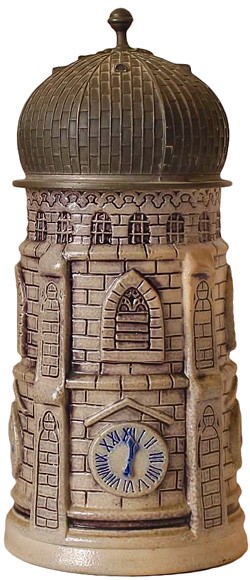
The Frauenkirche Tower usually attributed to Hauber & Reuther, but in this case identified as Simon Peter Gerz by the 0.5l capacity mark.

Impressed mark for Theodor Wieseler on the base of the Frauenkirche Tower is usually attributed to Hauber & Reuther.
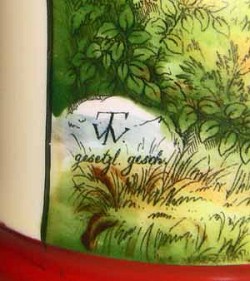
The signature on this hand painted porcelain stein which unusually, refers to the distributor and not to the artist.
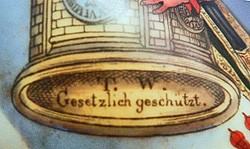
This mark is on the same stein showing T dep. W, below. The steinbase shown is part of the same front tableau of the same stein.
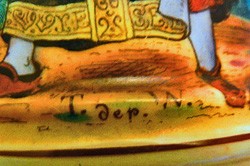
T.W. with the abbreviation "dep," for Déposé. This mark is on the outside toward the base of the stein.
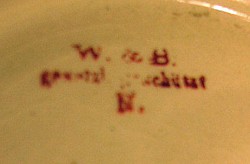
Wieseler & Beeri ink stamp on a Regimental stoneware stein.
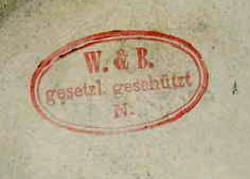
Wieseler & Beeri, W.&.B. Oval red ink stamp.
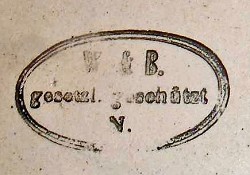
Wieseler & Beeri, W.&.B. Oval black ink stamp.
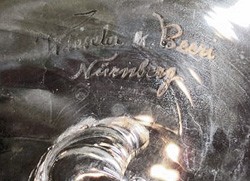
Etched signature in featured glass on right.

Merkelbach & Wick impressed mark, together with Wieseler & Beeri signature, plus copywrite. _______________ ×
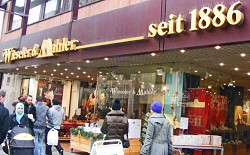
Wieseler & Mahler (since 1886), Karolinenstraße 27, Nuremberg. Photograph dated 2009.

Wieseler & Mahler ink stamp on stein "Nürnberg Arbeiter Turnfest 1912".
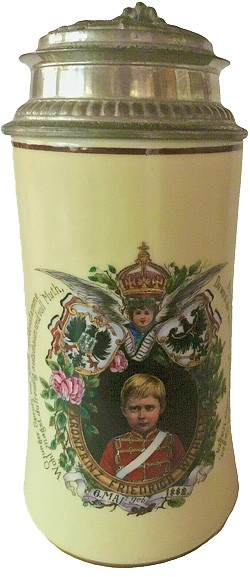
Stein commemorating the birth of Crown Prince Friedrich Wilhelm von Preussen. b. 06.05.1882. This stein was given on the occasion of his 13th birthday. In the lid you can find the parents of the crown prince, Wilhelm II and his wife Auguste Viktoria. Lid engraving commemorating Christmas 1895.
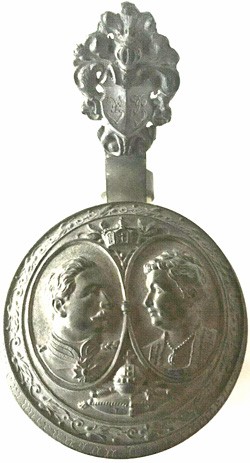
Pewter lid on above stein depicting Emperor Wilhelm II and his wife Empress Auguste Viktoria.
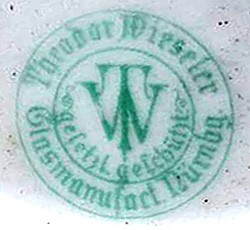
Concentric circles with an intertwined "TW" and around the outside, " Theodor Wieseler, Glasmanufakt. Nürnbg". _________________
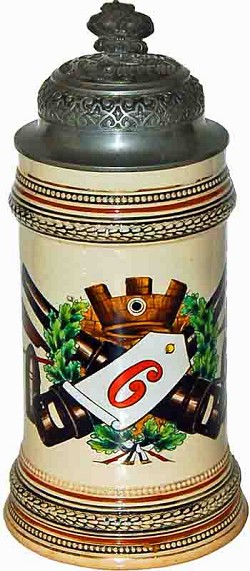
Stein manufactured by Marzi & Remy (probably #992), for Wiesler & Beeri with ink stamp depicting the Frauentorturm in Nuremberg
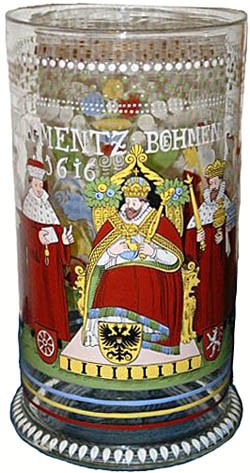
This beaker dated approx.1890, shows the Holy Roman Emperor (Matthias) with three Electors on either side of him. The list of place names celebrates the seven regions which formed the college of the Electors of the Holy Roman Empire in 1616, as follows: Bohemia, Palatine, Saxony, Brandenburg, Trier, Cologne & Mainz. (Original engraving of 1616). ______________________
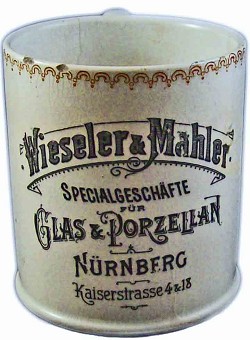
Publicity piece probably decorated at Kaiserstraße 4, made by Porzellanfabrik Utzschneider et Cie - Sarreguemines. Kaiserstrasse 4 & 18, are only two streets north of Karolinenstraße 27.
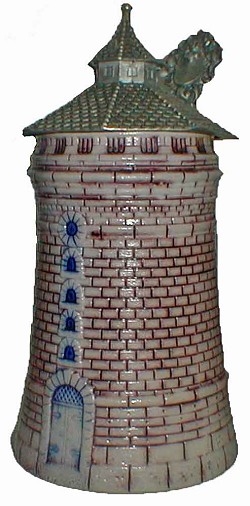
This stein represents one of the Nuremberg towers, namely the Frauentorturm, rebuilt to its present form in 1558, to guard the Frauentor (gate). This tower is unique due to its arched windows and round, top window. In 1849 the city wall was opened up close by, and a new gate, the Königstor was built for traffic access to the railway station. Due to essential road widening, the Königstor was demolished in 1892. Because of its proximity to the Königstor, the Frauentorturm was, and still is, often wrongly referred to, as the Königstorturm. Today, the Frauentor has pedestrian access only. This stein is usually attributed to Merkelbach & Wick for Theodor Wieseler. However earlier versions have also been seen with Freising / Hauber & Reuther capacity marks.
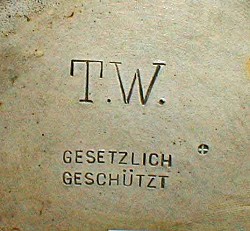
Impressed mark by Merkelbach & Wick, on the base of the Frauentorturm (above) for Theodor Wieseler.
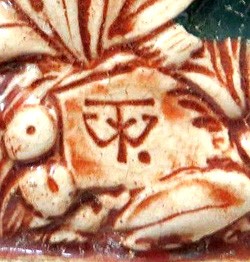
Impressed mark on Matthias Girmscheid #1199 stein, with set on lid. T.W. with the abbreviation "dep," for Déposé. This mark is on the outside toward the base of the stein.
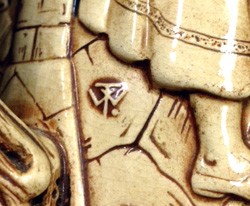
Vendor's mark near the handle base on presumably another Matthias Girmscheid stein . ____________________
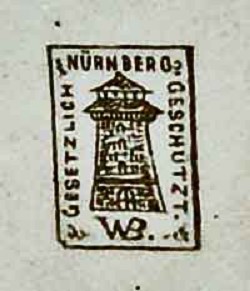
Featured stein manufactured by Marzi & Remy (probably #992), for Wieseler & Beeri with ink stamp featured in the 1894 version of the "Adressbuch der Porzellan- und Glas-Malereien", depicting the Frauentorturm in Nuremberg.
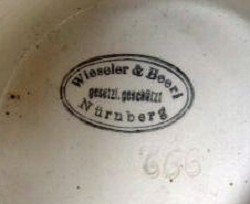
Wieseler & Beeri ink stamp on a Regimental stoneware stein, made by Marzi & Remy, mould #992.
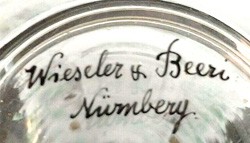
Inked signature on the base of a glass pokal.
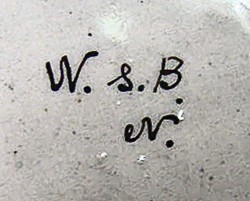
Ink freehand written on base of Marzi & Remy stein.
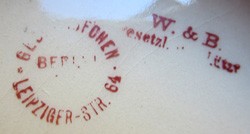
Supplied by Wieseler & Beeri to vendor, Gebr. Höfchen Leipzigerstraße 64, Berlin, which was founded as F.W. Seldte in 1861, this company was last digitally recorded in 1991. This address is now a concrete and glass building containing a CityHotel and Löwenbräu Bierstube. _________________ ×
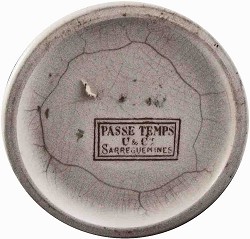
Ink stamp on featured tankard, showing Porzellanfabrik Utzschneider et Cie - Sarreguemines, from their "Passe Temps" range.
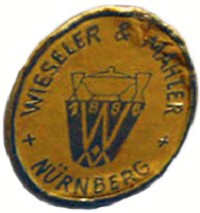
Sticker on the underside of a porcelain figurine, showing the founding date of Süddeutsche Glasmanufaktur - Theodor Wieseler.





























